Continuing Tom's analysis of Norman Rockwell's illustrations for Mark Twain's Adventures of Tom Sawyer...
Illustration #4
I guess today the schoolmaster switching Tom would be suspended and investigated for child abuse, but in those days the schoolmaster was appropriately named. He maintained discipline with an understood authority. Rockwell was able to choose the scenes in the books according to whether they would make a good illustration or not, and making sure they were spread out evenly throughout the story. He noted that in Mark Twain’s stories, there was a good scene to illustrate on every page. He commented that it made his job easy and enjoyable, because Mark Twain was such a great writer.

The action in this scene is intense, compared to the rest of the illustrations, and Rockwell conveys that feeling perfectly. The large triangular shape of the dark jacket of the schoolmaster, is menacing and adds to the tension. It also functions to counter change the light background. As I look at this illustration, I can almost feel and see real movement in the two figures. It is so convincingly portrayed, that we can hear and feel the switch slapping against Tom’s pants and a convincing yelp. If the schoolmaster used his hand instead of a switch, Tom would hardly feel it, as his loose pants would shield him, having little effect. The humiliation of being switched in front of the whole class, was probably worse than the sting of the switch. Notice all the switches broken on the floor.
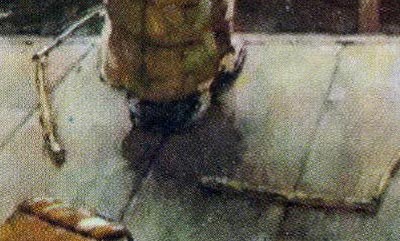
Again Rockwell uses the combination of angled figures (organic forms), and a flat background of horizontal and vertical lines (geometric forms). He liked the combination, and used it over and over to perfection. The lamp, the globe and the book on the floor create secondary visual interests. Rockwell never added props that were unnecessary, and never left out props that would explain the scene better. His understanding for clarity and authenticity, and his understanding of composition and design, were always compatible.
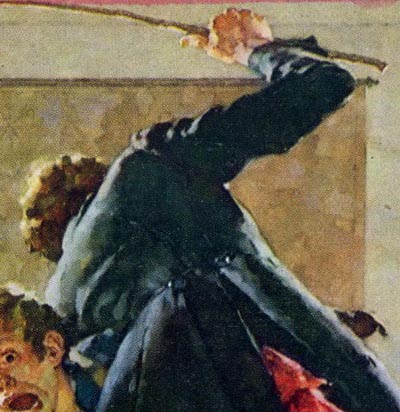
Rockwell combines an effective pattern of warm tones (map on wall, windows and frames, bench, schoolmaster’s pants, book on floor, the globe and the hair and skin tones).. cool tones are (the wall, lamp shade, Tom’s shirt and pants, schoolmaster’s jacket, student’s shirt and the floor). Warms and cools also function to counter change and separate the various shapes from each other. Again, he used the red handkerchief and the girls dress as red accents. Every decision Rockwell made was vital and functional.
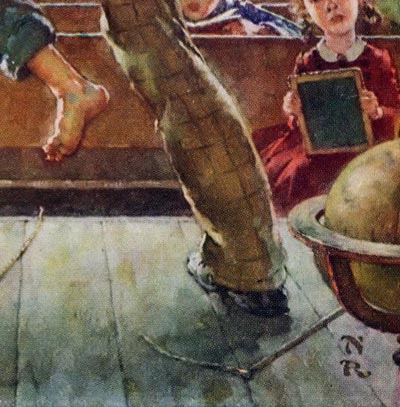
Illustration #5
Norman Rockwell commented in his biographical book “My Adventures As An Illustrator”, that he didn’t always choose to illustrate scenes that were of major importance to the story. As mentioned in the previous illustration, he said he “picked scenes that would make good paintings”. That may sound odd, but often a key scene in the story, does not always come off visually. Rockwell instinctively knew what made a “good picture”. He said that sometimes it would, in fact, be a scene that was described in just a few short sentences, and rather insignificant to the story. The scene of Tom climbing out of the window is but a brief moment in the book. But, it says volumes about the kind of boy Tom Sawyer was, and his mischievous adventuresome ways. He had the ability to convey that, perhaps better than almost any other illustrator. Rockwell’s ‘cut to the chase’, ‘straight ahead’ point of view in most of this compositions, leaves no doubt what is being depicted. In my opinion, he was a master at visually communicating an idea.

Rockwell painted from live models and stubbornly refused to use the camera that would later (after 1939) give him more flexibility and latitude for his compositions. This scene was obviously painted from a model in his studio, in a situation where he had complete control of the pose and lighting. Maintaining the right expression enabled him to more easily change his point of view by looking at the scene from below or from above the subject. But would that have really improved this illustration? Since it wasn’t a tension-filled moment, like Tom falling to the ground, being caught sneaking out, or getting stuck climbing down to the ground, etc., a dramatic approach to the composition would have been overkill and misleading.
Even in the soft cool cast of moonlight, Rockwell shows as much clarity and resolve in the figure and clap board house as if it were broad daylight. He simply adds blue and green tones to all the hues, complementing them with an accent of bright yellow from the neighbor’s window and a hint of the angle on the neighbor’s roof, creates subtle opposing diagonals.
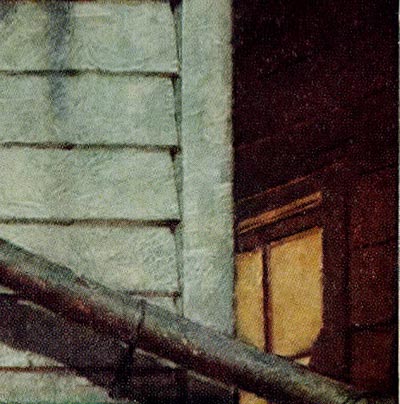
This helps relieve the stronger diagonals of the eves, the pipe and the tree shadows on the house. For the most part, the house and window are depicted in patterns of geometric horizontal and vertical lines, which Rockwell often used in his compositions.
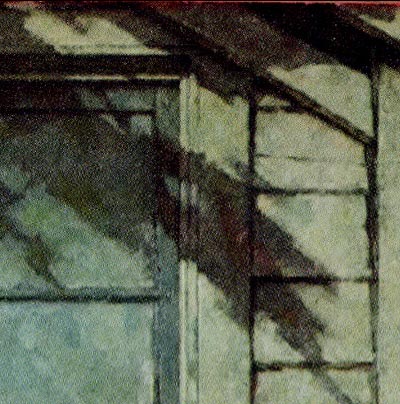
The water pitcher, wash basin, soap and the strip of cloth wrapped around Tom’s toe, are typical descriptive subtleties that Rockwell became identified with for most of his illustrations.
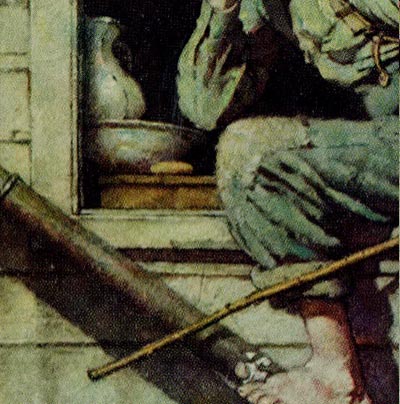
* Tom Watson is a retired West Coast illustrator, art director and educator. He has been a frequent contributor to Today's Inspiration and his storyboard work for film was a subject of a post on my other blog, Storyboard Central.
This week's images are © MBI/Heritage Press, Date (1936 or 1940) and are used with the permission of the Norman Rockwell Museum. This past weekend the museum featured the grand opening of a traveling exhibition, American Chronicles: The Art of Norman Rockwell.
Stephanie Plunkett, Chief Curator of the Museum would like readers to know that the Museum does travel an exhibition of signed lithographic prints from the Tom and Huck series to other museums and cultural centers. Stephanie writes, "We do have two upcoming bookings for that exhibition are listed below, so perhaps your readers will have the opportunity to visit if they live in the region."
Here is the information about the traveling exhibition:
Norman Rockwell's Tom Sawyer and Huckleberry Finn
Nova Southeastern University, Fort Lauderdale-Davie, Florida
November 14, 2009 through January 29, 2010
Averitt Center for the Arts, Statesboro, Georgia
March 12, 2010 through May 7, 2010
"It also might be interesting to note that the original paintings for the series are in the collection of the Mark Twain Museum in Hannibal, Missouri. The originals are beautiful. A study from the series will be on view in our upcoming exhibition, Norman Rockwell: Behind the Camera, which opens on November 7, 2009."
Wonderful post - thanks for pointing out some of the obvious things I had missed while enjoying his illustrations. A technical master!
ReplyDeleteI love the incidental touches like the reoccurring bandaged toe in both pictures.
ReplyDeleteThere's great pantomime with the expressions of the onlooking kids: the one obviously enjoying Tom's demise and the sympathetic girl in red,(Becky?).
Tom's asymmetric mouth help convey his pain and humiliation. Great stuff!
TOM....Just a great week on NR, Tom Sawyer, Huck Finn, their adventures, and the absolutely perfect combo of Rockwell and Mark Twain. I grew up with the two books, read them several times....but before these publications came out. I'd like to see again the black and white illustrations (there weren't many as I recall) and find out who illustrated those earlier editions. I'll check....they may somewhere in our family. Almost taboo to critique NR, but I had said earlier that his cartooned kids were a bit too cute....a bit precious. Still think so at times....and I notice a difference in his Tom Sawyers as if he'd used a different model on some. Hey....the quibbler here....I sound like some of the art directors I dealt with! Thanks for the beaucoup analysis and commentary all through....again, a great week!
ReplyDeleteThanks for your comments Kathleen and Joel. I'm glad you are enjoying Rockwell's illustrations as I do.
ReplyDeleteCharlie, I'm glad you commented on Rockwell's kids. I too felt his kids became a little too cartoonish on occasions, but don't see as much of that in the Tom and Huck series. Of course, the general public loved those "too precious" kids, and he probably loved all the compliments, making it hard to stop doing it. I guess a lot of our personality, experiences and genetic characteristics show up in our illustrations. He could have caved in to the critiques, but he just kept on truckin. Interesting observation about the different looks Tom Sawyer has. illustration 7, coming up soon, shows Huck smoking a pipe, and for a long time I thought it was Tom! Huck looks considerably different in the book , "The Adventures of Huckleberry Finn" than the way he is portrayed in "The Adventures of Tom Sawyer"... in the former, his hair is darker and somewhat different features. I would love to know the story behind that inconsistency. But then, Rockwell was critical of some of Lyendecker's illustrations, and he was a huge fan of Lyendecker's work.
Hey, now we both sound like one of those pain in the butt art directors! ;-)
Glad you are enjoying the posts.
Tom Watson